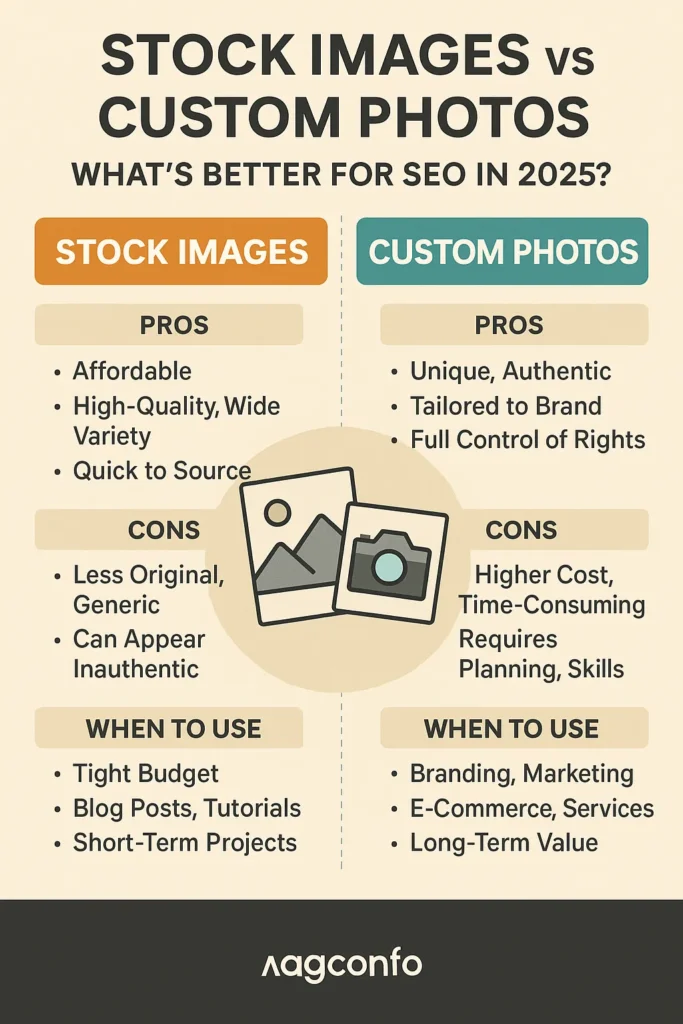
Stock Images vs Custom Photos – What’s Better for SEO in 2025?
Imagine walking into a local cafe you’ve never visited before. You open their menu and see beautiful, glossy food images—but something feels off. You’ve seen those pictures somewhere else. Maybe on another menu. Or an ad. That’s the problem with stock images—they’re polished, yes, but often forgettable.
Now think of scrolling through a small business blog that shows a candid photo of the owner making candles in their studio, with a dog sitting quietly in the corner. It’s imperfect. But you pause. You feel something. You remember it.
That’s the magic of custom photos in 2025—and that’s exactly what this article explores.
📸 Stock Photos: Easy to Use, Hard to Remember
We’ve all used them. Stock photo sites like Pexels, Shutterstock, or iStock are lifesavers when you’re tight on time or budget. You get access to thousands of high-quality images, ready to plug into your content.
And let’s be honest—they often look great. Clean lighting, beautiful people, professionally shot. But here’s the catch: so many other people are using the same images.
One of my clients, a fitness coach, once asked why her “About” page wasn’t converting well. Turns out the stock photo of a smiling, muscular guy lifting weights? It was used by a protein powder brand and a gym halfway across the country. Her potential clients sensed it wasn’t real—and bounced.
Stock images are convenient. But that convenience can come at the cost of trust, uniqueness, and yes, SEO.
📷 Custom Photos: Harder, But Hugely Rewarding
Now let’s flip the coin. Custom photos—those you take yourself or commission—require more work. Maybe even a little discomfort if you’re not used to being behind the camera. But they are yours. Authentically, fully yours.
There’s something powerful about a blog showing the real face of the writer, the actual workspace, the hands that make the product. It builds connection.
For example, one food blogger I know, Sanya, started using her phone to snap photos of her cooking process—flour on the counter, her mom’s handwritten recipe, steam rising from the stove. Not only did her Instagram engagement grow, but her blog started ranking higher in image search. Google prefers originality, and audiences do too.
🧠 Why Google Cares About Unique Visuals
Search engines have become pretty smart. In 2025, Google looks at more than just text—it evaluates image originality, context, metadata, and even user behavior around visuals.
If your blog post has a unique photo with a relevant filename, alt text, and a clear relationship to the content, it sends a strong signal: this content is real and valuable.
Stock images, especially ones that are overused, don’t provide that same value. In fact, Google is less likely to feature them in image search or Discover results, simply because they don’t offer anything new.
So even if it takes a few extra minutes to take your own shot, that effort can help your SEO and visibility significantly.
🔍 Real-World Wins: The Custom Image Advantage
Let’s look at some real examples:
- A boutique clothing brand in Jaipur replaced all model shots from stock sites with behind-the-scenes photos of their local tailors at work. Their time-on-site doubled, and people started sharing their story—not just their products.
- A digital marketer used to use abstract stock backgrounds in her blog headers. Once she began designing simple banners using her own illustrations and snapshots of her desk setup, her Pinterest traffic grew 4x.
- A solo entrepreneur selling herbal tea online hired a friend to shoot her packing orders at home. That image went viral on Reddit. Sales soared. That never happened with the stock photo of a random teacup she’d used before.
Moral of the story? Custom visuals are connection points.
📈 SEO Benefits of Custom Photos
Custom images do more than just “look nice.” They impact real SEO metrics:
- Higher dwell time: Users stay longer when they sense content is personal.
- Lower bounce rate: People don’t just skim—they scroll, explore, and engage.
- Better image rankings: Unique images are more likely to appear in search.
- Improved CTR: Authentic thumbnails on Google or Pinterest stand out more.
Google wants to serve results that feel alive. Custom visuals make that happen.
🛠️ Tools That Help You Create Great Custom Images (Without a Studio)
You don’t need a DSLR or pro lighting kit to shoot your own photos. Here’s what many creators and small business owners use:
- Smartphone + natural light: Shoot by a window in the morning or golden hour.
- Editing tools: Use Snapseed, Lightroom Mobile, or Canva to tweak brightness and add light branding.
- Props around you: Your laptop, your notebook, your pet—real is beautiful.
- Tripod or stand: Helps with consistency and hands-free shooting.
The point isn’t perfection—it’s presence.
🌍 Local SEO? Go Custom Every Time
If you’re targeting a specific city or region, don’t even think twice—custom wins. A photo of your storefront, your team, your neighborhood landmarks, or a real customer adds trust that stock just can’t deliver.
Imagine a dentist in Mumbai using a stock image of a smiling white model. That immediately creates disconnect. Now imagine showing her with her actual team and a real patient—huge trust bump.
🎯 When You Can Use Stock (Just Do It Right)
Stock photos aren’t evil. They still have a place:
- Backgrounds or abstract elements
- Icons, buttons, mockups
- Time-sensitive content (e.g., announcements)
- Posts where style matters more than realism
But always customize: crop, overlay text, apply a brand filter, or blend it with your own visuals.
✅ Final Thoughts: What’s Your Visual Story?
In 2025, SEO isn’t just about ranking for keywords. It’s about building experiences. Stock photos might fill a space—but custom photos tell your story. And your story is the one thing your competition can’t copy.
So next time you’re writing a blog post, ask yourself: can I show something real here?
Your readers—and search engines—will thank you for it.

